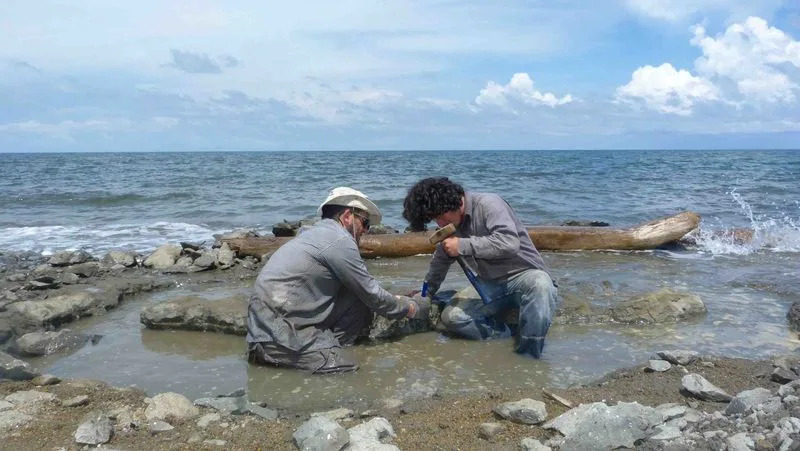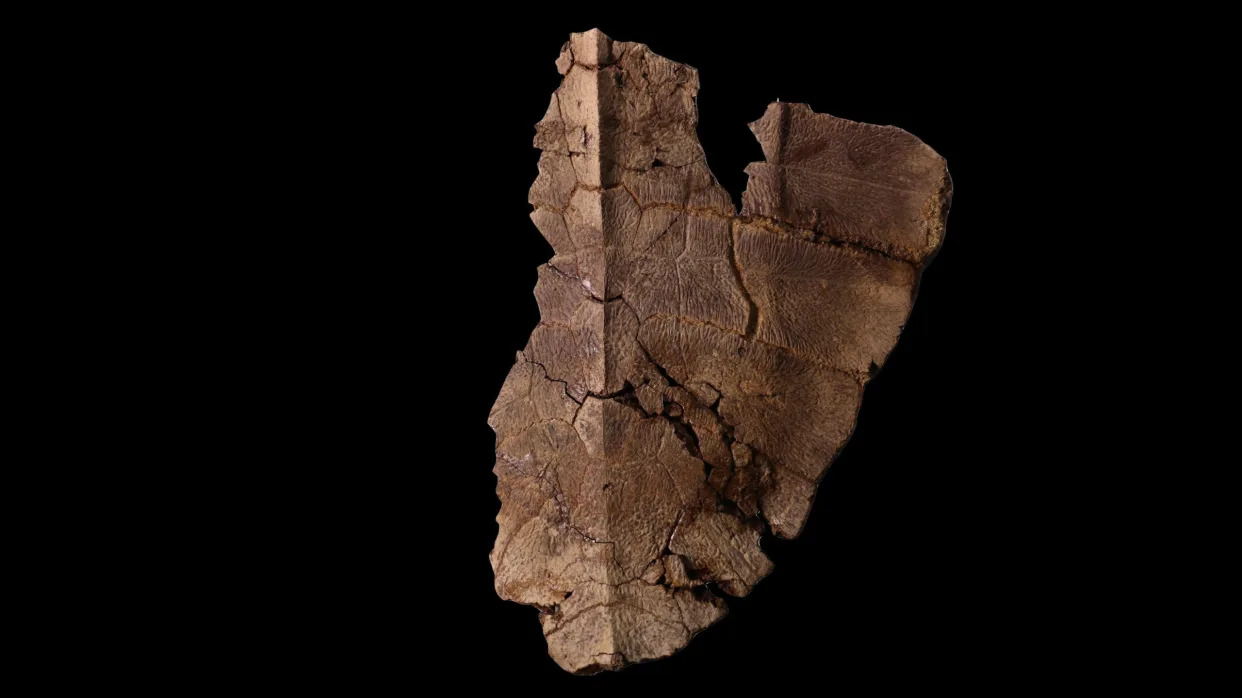Reuters
Thu, September 28, 2023

Researchers excavate the 6 million year old fossil remains of a sea turtle of the genus Lepidochelys near La Pina along the Caribbean coast of Panama
(Reuters) - Remnants of DNA have been discovered in fossilized remains dating to 6 million years ago of a sea turtle closely related to today's Kemp's ridley and olive ridley turtles, marking one of the rare times genetic material has been identified in such ancient fossils of a vertebrate, researchers said on Thursday.
The researchers said some bone cells, called osteocytes, were exquisitely preserved in the fossil, which was excavated along Panama's Caribbean coast in 2015. The fossil is partial, with a relatively complete carapace - the turtle's shell - but not the rest of the skeleton. The turtle would have been about a foot (30 cm) long when alive, they said.
In some of the osteocytes, the cell nuclei were preserved and reacted to a chemical solution that allowed the researchers to recognize the presence of remnants of DNA, the molecule that carries genetic information for an organism's development and functioning, said paleontologist Edwin Cadena, lead author of the study published in the Journal of Vertebrate Paleontology.
"I want to point out that we did not extract DNA, we only were able to recognize the presence of DNA traces in the nuclei," added Cadena, of Universidad del Rosario in Bogota and the Smithsonian Tropical Research Institute.
DNA is quite perishable, though in the right conditions it has been preserved in some ancient remains. Researchers last year reported the discovery of DNA from animals, plants and microbes dating to about 2 million years ago from sediment at Greenland's remote northernmost point.
Cadena said the only older vertebrate fossils than the newly described turtle to have been found with similar DNA remnants were of two dinosaurs - Tyrannosaurus, which lived about 66 million years ago, and Brachylophosaurus, which lived about 78 million years ago. Cadena said DNA remnants also have been reported in insects dating to tens of millions of years ago.
The turtle is from the same genus - Lepidochelys - as two of the world's seven living species of sea turtles - the Kemp's ridley, the world's smallest sea turtle, and the olive ridley, Cadena said. Kemp's ridley, with a triangular-shaped head and a slightly hooked beak, is primarily found in the Gulf of Mexico. The olive ridley, which closely resembles the Kemp's ridley, has a larger distribution, primarily found in the tropical regions of the Pacific, Indian and Atlantic oceans.
The fossil represents the oldest-known member of Lepidochelys and helps to shed light on the poorly understood evolutionary history of this genus, the researchers said. They did not identify it by species because the remains were too incomplete, Cadena said.
"Each fossil, each fossil site has specific conditions of preservation that in some cases could have favored preservation of original biomolecular remains such as proteins and DNA," Cadena said.
"Maybe in the future and with more studies of this kind, we could be able at some point to sequence very small pieces of DNA and to infer things about their close relatives or involve that information in a broader molecular evolutionary study," Cadena added.
(Reporting by Will Dunham in Washington; Additional reporting by Elida Moreno; Editing by Rosalba O'Brien)
This 6-million-year-old turtle shell still has some DNA
Laura Baisas
Fri, September 29, 2023

The researchers found preserved bone cells in the carapace, which exhibited structures like the nucleus of a cell, where DNA traces were found.
Sea turtles have been around for at least 110 million years, yet relatively little is known about their evolution. Two of the most common sea turtles on Earth are olive ridley and Kemp’s ridley turtles that belong to a genus called Lepidochelys that could help fill in some of the gaps of sea turtle biology and evolution. A team of paleontologists not only discovered the oldest known fossil of turtle from the Lepidochelys genus, but also found some traces of ancient turtle DNA. The findings are detailed in a study published September 28 in the Journal of Vertebrate Paleontology.
The DNA comes from the remains of a turtle shell first uncovered in 2015 in the Chagres Formation on Panama’s Caribbean coast. It represents the oldest known fossil evidence of Lepidochelys turtles. The turtle lived approximately 6 million years ago, curing the upper Miocene Epoch. At this time, present day Panama’s climate was getting cooler and drier, sea ice was accumulating at Earth’s poles, rainfall was decreasing, sea levels were falling.
“The fossil was not complete, but it had enough features to identify it as a member of the Lepidochelys genus,” study co-author and Universidad del Rosario in Bogotá, Colombia paleontologist Edwin Cadena tells PopSci. Cadena is also a research associate at the Smithsonian Tropical Research Institute in Panama.
The team detected preserved bone cells called osteocytes. These bone cells are the most abundant cells in vertebrates and they have nucleus-like structures. The team used a solution called DAPI to test the osteocytes for genetic material.
“In some of them [the osteocytes], the nuclei were preserved and reacted to DAPI, a solution that allowed us to recognize remains of DNA. This is the first time we have documented DNA remains in a fossilized turtle millions of years old,” says Cadena.
According to the study, fossils like this one from vertebrates preserved in this part of Panama are important for our understanding of the biodiversity that was present when the Isthmus of Panama first emerged roughly 3 million years ago. This narrow strip of land divided the Caribbean Sea and the Pacific Ocean and joined North and South America. It created a land bridge that made it easier for some animals and plants to migrate between the two continents.
This specimen could also have important implications for the emerging field of molecular paleontology. Scientists in this field study ancient and prehistoric biomatter including proteins, carbohydrates, lipids, and DNA that can sometimes be extracted from fossils.
Molecular paleontology aims to determine if scientists can use this type of evidence to determine more about the organisms than their physical shape, which is typically what is preserved in most fossils. Extracting this tiny material from bones was critical in sequencing the Neanderthal genome, which earned Swedish scientist Svante Pääbo the 2022 Nobel prize in physiology or medicine.
“Many generations have grown up with the idea of extracting and bringing back to life extinct organisms,” says Cadena. “However, that is not the real purpose of molecular paleontology. Instead, its goal is to trace, document, and understand how complex biomolecules such as DNA and proteins can be preserved in fossils.”
This new turtle specimen could help other molecular paleontologists better understand how soft tissues can be preserved over time. It could also shift the idea that original biomolecules like proteins or DNA have a specific timeline for preservation in fossils and encourage re-examining older specimens for traces of biomolecules.
No comments:
Post a Comment